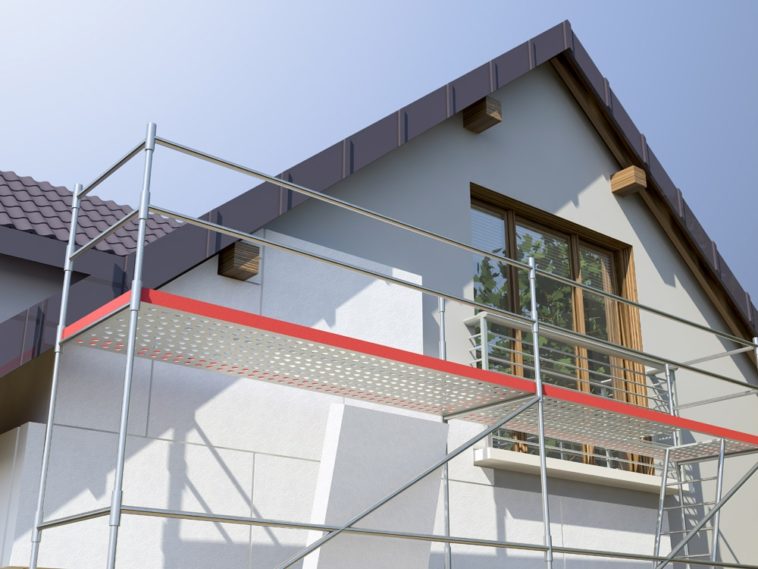From simple cleaning to thermal insulation from the outside, renovating its facade involves taking into account many points, aesthetic of course, but above all technical. From reflection on the project to its implementation, follow our practical guide.
Your facade has aged, and you can feel it, the time has come for a facelift. Especially since the mayor of your town may be putting pressure on you. Because yes, an elected official can require of you that you restore your facade in state.
Under article L132-1 of the Construction and Housing Code, all facades must be maintained in order to maintain cleanliness and safety. If the work has not been started, the town hall can even initiate an injunction procedure.
Facade renovation: the preliminary steps
So if your facade deteriorates, don’t delay too long. But above all, as an owner, you must “identify your needs: is it a cooling process, or energy saving by insulating your facade?” asks Sabine Strohmann, finishing product manager at the plaster and paint manufacturer Sto.
Then some administrative procedures are to be expected. An owner must indeed transmit a prior declaration of work to the town hall’s town planning department of its commune. The applicable rules are generally those of the Local Urban Planning Plan (PLU) or the POS (Land Use Plan), which imply compliance with certain requirements relating to materials and colors in particular.
Finally, before any work, it is strongly recommended to subscribe to a damage insurance contract. This is intended to protect an owner or a co-ownership in the event of a noted fault.
First step: clean your facade
You are in good standing, let’s go! Before getting to the heart of the matter, it is essential to clean the support. Depending on the condition of your facade and the diagnosis, several treatments may be considered. “The identification of the pathology of the facade is essential. If there are microcracks, if the surface is washed out, if it is prone to peeling, the remedy to apply will be different “explains Sabine Strohmann. For a simple refresh, it will first be necessary to clean the facade, strip it if necessary in order to remove the old traces of plaster or paint for example.
There are many cleaning methods available and professional advice should be sought to move in the right direction. If the high pressure cleaning is formidable against encrusted dirt, it is also very aggressive and can be contraindicated on certain facades. a dry scrub, it will be used to eliminate traces of pollution or graffiti, and will be suitable for porous walls such as concrete, wood, brick, or stone …
THE’hydrogommage is for its part “better suited to fragile materials, while offering the advantage of retaining dust” can we read Leroymerlin.fr. the dry sandblasting is intended for hard materials, and water-blasting will rather be used to strip fragile facades and exterior woodwork.
Protect your facade
You will understand: when it comes to the treatment to be applied, we are not all equal. “The facade must be cleaned and treated according to the context and the environment. If the building is in a wetland with a lot of vegetation, it is preferable to clean, protect and decontaminate the facade against mold, algae, fungi (curative and preventive, editor’s note). Depending on the condition of the substrate, it may be necessary to apply a primer “.
On a “chalking” facade, for example, this primer is essential for the paint or the finishing plaster to adhere well to the support. For these preliminary treatments, the manufacturers offer vast ranges supposed to meet all the scenarios: from a simple cleaner, via the decontaminant or the stripper.
The latter is not to be neglected for the most damaged facades and / or subject to humidity. It will clog microcracks and porosities by forming a waterproof barrier to rainwater, while letting the walls breathe. It will thus prevent the appearance of molds, lichens, dirt, erosion, prevent frost-related detachment, etc.
Fill the cracks in its facade
In the event that cleaning reveals cracks, again, caution is required. It is already necessary to make sure it is not a “living” crack, by having milestones. After checking, if the crack is stable, it will suffice to seal it with a plaster, a mortar or a water repellent for example.
The task is more difficult with the living cracks. “They can lead to weakening of the structure. You can fill it with a coating or a special external flexible mastic which will follow the movements of the support. But if the crack gets worse, it is better to seek professional advice, “Leroy Merlin says. Note that the larger the crack, the heavier the treatments to be applied.
Coating, painting, cladding …: what finish for my facade?
After preparing the support, it’s time to finish! Here again, the solutions are numerous and the price ranges vary greatly, ranging from € 16 per m2 for paints, up to € 200 per m2 for a top-of-the-range exterior thermal insulation (ITE) system. range.
For paints, 4 types of formulations exist: acrylic, pliolite, hydro or siloxane. “Beyond the composition, we will choose a paint according to the support and the desired characteristics : appearance (matt to gloss), range and intensity of colors “explains Sabine Strohmann.
Note that different formulas will have to be applied for wooden or metal elements, such as carpentry for example. For a more structured rendering, the individual will rather set his sights on the plaster, from coated mineral-based monolayers or a traditional coating.
For rustic aficionados, make way for cladding in solid, reconstituted or composite wood. Relatively simple to install, it will give charm and warmth to your facade. Also come the cladding boards (with or without joints) in natural stone, reconstituted stone or cast concrete, briquette … Ideal to give a traditional charm to his house.
To go further, some coatings even include technical characteristics: When some will reflect more solar rays in order to limit the phenomena of overheating, others will fight against fouling thanks to a beading effect.
Insulation from the outside: a thermal jacket for the home
A facelift is also an opportunity to embark on energy renovation work. Increasingly popular in this period of energy transition, thermal insulation from the outside (ITE) consists of applying a complete system to a facade in order to strengthen the thermal performance of the home, in winter and summer. This system generally includes a bond for the substrate, an insulation, fasteners, a masking underlay, a reinforcing mesh, and a finishing plaster.
The insulation is usually a rock wool or a polystyrene panel 15 to 20 cm thick. The finishing plasters are not the same as those used for a simple renovation. “Polystyrene and rock wool live and metal too. It can expand when it is hot and contract when it is cold. It is therefore necessary to apply flexible and impact resistant coatings. -enduit is generally accompanied by a reinforcement. The idea is that all the elements are able to follow the movement “explains Sabine Strohmann. On the maintenance side, “an ITE facade can be washed with a very low pressure karcher” adds the specialist.
It is obvious that given the complexity of the process (installation of the system, management of thermal bridges, singular points, etc.), it is preferable to leave your tools in the garage and trust a professional.
It should also be noted that the constitution of this coat for housing is expensive. But in a context of the fight against global warming and the increase in the energy bill, it is an investment in time, for the wallet, and for the planet. Especially since, if installed by a professional RGE (Recognized guarantor of the environment), the owner is eligible for aid such as the MaPrimeRénov ‘device.



